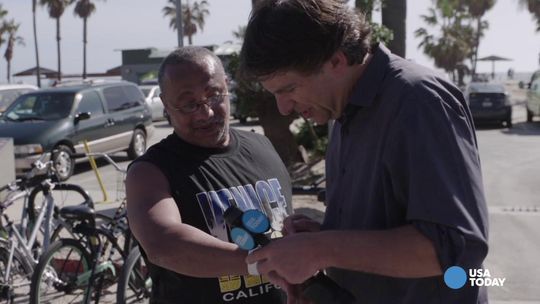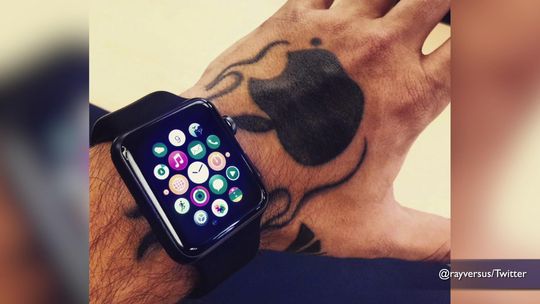Apple Watch has a tattoo problem, but that may be it

4907
25Share This Story!
Let friends in your social network know what you are reading about
Apple Watch has a problem with tattoos
While Apple reportedly scrambles to fix issues with its Apple Watch related to the taptic engine, another issue has potentially cropped up with the smartwatch: tattoos.
Try Another
Audio CAPTCHA
Image CAPTCHA
Help
CancelSend
Sent!
A link has been sent to your friend's email address.
Posted!
A link has been posted to your Facebook feed.
Brett Molina & Edward C. Baig 12:46 a.m. EDT May 1, 2015

UP NEXT
03
After reports surfaced that the Apple Watch's heart rate monitor may not work in tattoos or dark skin, USA Today's Jefferson Graham headed to the boardwalk in Venice Beach, CA to test it out.

Alexander Craig, a studio assistant at TuneIn.com studios in Venice Beach, has tattoos and dark skin--and a heartbeat.(Photo: Jefferson Graham)
And then there was TattooGate.
Social media is all abuzz with anecdotes and posts on Reddit and Twitter that the Apple Watch sensor that measures heart rate does not work well on some users that have tattoos on their wrists.
"Doubt they asked at checkout if you had any tattoos. ... It's all about da money yo," tweeted Kayla Sweeney.
"It turns out you must choose between a wrist tattoo and an #AppleWatch," tweeted Steve Burgess.

UP NEXT
03
Days after the launch of the Apple Watch, users on Reddit and Twitter began reporting the watch doesn't seem to work so well on tattooed wrists. Jen Markham (@jenmarkham) explains. Buzz60
In fact, the issue has some merit. While not commenting specifically on the reports, Apple directed USA TODAY to its website[1].
Apple's site reads:
"Many factors can affect the performance of the Apple Watch heart rate sensor. Skin perfusion is one....Permanent or temporary changes to your skin, such as some tattoos, can also impact heart rate sensor performance. The ink, pattern, and saturation of some tattoos can block light from the sensor, making it difficult to get reliable readings."
What is less clear for now, is speculation that people of color may also experience trouble with some Apple Watch features.
The science behind the Watch's sensor indicates it is possible. That's not the same thing, of course, as an actual problem.
"The signal to noise ratio when you use light to try and measure blood flow in people as Apple is doing is much lower in someone who has high melanin content," says Steven LeBoeuf, a co-founder of Valencell, a producer of biometric sensors. His company hasn't completed its tests with the Apple Watch.

Dave Walker hasn't experienced issues with his Apple Watch. (Photo: Dave Walker)
His advice for dark-skinned people or people who have tattoos is to try the heart rate monitor and other functions in the Apple Store before buying.
'OVERBLOWN'
USA TODAY tested the Apple Watch on three African Americans in Los Angeles. The heart rate feature worked perfectly on each person.
That's also been the experience of Dave Walker of Troy, Mich., who is African American and an owner of an Apple Watch Sport model. Walker told USA TODAY that he has had no problems with wrist detection or the heart rate monitor.
"It's obvious to me, and I'm by no means an expert in the field, that tattoo ink is very different from skin pigment. I'm not sure why people are confused by that. I really think this one is really, really overblown."
Shari Lipner, a dermatologist and assistant professor at Weill Cornell, doesn't believe the watch "would be a problem with African Americans or people with dark skin. This is really a different type of pigment (than) in the tattoos."
DEPENDS ON INK COLOR
As for people with tattoos, Lipner suggested it would only be an issue if the tattoo is directly below the watch sensors, adding that smartwatch owners with amateur or light-colored tattoos also shouldn't run into snags. But the darker blue or black inks on some tattoos could interfere with how the sensor reads your heart rate, giving users unusual numbers.
The heart rate sensor on the Apple Watch uses technology called photoplethysmography. Here's how it works, according to Apple:
"Blood is red because it reflects red light and absorbs green light. Apple Watch uses green LED lights paired with light-sensitive photodiodes to detect the amount of blood flowing through your wrist at any given moment. When your heart beats, the blood flow in your wrist — and the green light absorption — is greater. Between beats, it's less. By flashing its LED lights hundreds of times per second, Apple Watch can calculate the number of times the heart beats each minute — your heart rate."
Tattoos are not the only issue Apple has been dealing with this on the Watch. A defective piece of the Apple Watch produced by a Chinese supplier — the taptic engine used to provide feedback via vibrations — reportedly has limited the availability of the watch, causing some buyers to have to wait until the summer to receive the smartwatches.
Meantime when it comes to the issues surrounding TattooGate, Walker brings his own perspective: "As an African American I'd say there is probably more important things going on in the world. Put it this way, my watch is not the thing that is pissing me off this week."
Follow Brett Molina on Twitter: [2]@brettmolina23[3]; follow Ed Baig @edbaig[4].
Read or Share this story: http://usat.ly/1ztLvcY
USA NOW
Calif. residents skirt drought rule by using wastewater
May 06, 2015
0) { %>
0) { %>
4907
25Share This Story!
Let friends in your social network know what you are reading about
Apple Watch has a problem with tattoos
While Apple reportedly scrambles to fix issues with its Apple Watch related to the taptic engine, another issue has potentially cropped up with the smartwatch: tattoos.
Try Another
Audio CAPTCHA
Image CAPTCHA
Help
CancelSend
Sent!
A link has been sent to your friend's email address.
Posted!
A link has been posted to your Facebook feed.
Brett Molina & Edward C. Baig 12:46 a.m. EDT May 1, 2015

UP NEXT
03
After reports surfaced that the Apple Watch's heart rate monitor may not work in tattoos or dark skin, USA Today's Jefferson Graham headed to the boardwalk in Venice Beach, CA to test it out.

Alexander Craig, a studio assistant at TuneIn.com studios in Venice Beach, has tattoos and dark skin--and a heartbeat.(Photo: Jefferson Graham)
And then there was TattooGate.
Social media is all abuzz with anecdotes and posts on Reddit and Twitter that the Apple Watch sensor that measures heart rate does not work well on some users that have tattoos on their wrists.
"Doubt they asked at checkout if you had any tattoos. ... It's all about da money yo," tweeted Kayla Sweeney.
"It turns out you must choose between a wrist tattoo and an #AppleWatch," tweeted Steve Burgess.

UP NEXT
03
Days after the launch of the Apple Watch, users on Reddit and Twitter began reporting the watch doesn't seem to work so well on tattooed wrists. Jen Markham (@jenmarkham) explains. Buzz60
In fact, the issue has some merit. While not commenting specifically on the reports, Apple directed USA TODAY to its website[5].
Apple's site reads:
"Many factors can affect the performance of the Apple Watch heart rate sensor. Skin perfusion is one....Permanent or temporary changes to your skin, such as some tattoos, can also impact heart rate sensor performance. The ink, pattern, and saturation of some tattoos can block light from the sensor, making it difficult to get reliable readings."
What is less clear for now, is speculation that people of color may also experience trouble with some Apple Watch features.
The science behind the Watch's sensor indicates it is possible. That's not the same thing, of course, as an actual problem.
"The signal to noise ratio when you use light to try and measure blood flow in people as Apple is doing is much lower in someone who has high melanin content," says Steven LeBoeuf, a co-founder of Valencell, a producer of biometric sensors. His company hasn't completed its tests with the Apple Watch.

Dave Walker hasn't experienced issues with his Apple Watch. (Photo: Dave Walker)
His advice for dark-skinned people or people who have tattoos is to try the heart rate monitor and other functions in the Apple Store before buying.
'OVERBLOWN'
USA TODAY tested the Apple Watch on three African Americans in Los Angeles. The heart rate feature worked perfectly on each person.
That's also been the experience of Dave Walker of Troy, Mich., who is African American and an owner of an Apple Watch Sport model. Walker told USA TODAY that he has had no problems with wrist detection or the heart rate monitor.
"It's obvious to me, and I'm by no means an expert in the field, that tattoo ink is very different from skin pigment. I'm not sure why people are confused by that. I really think this one is really, really overblown."
Shari Lipner, a dermatologist and assistant professor at Weill Cornell, doesn't believe the watch "would be a problem with African Americans or people with dark skin. This is really a different type of pigment (than) in the tattoos."
DEPENDS ON INK COLOR
As for people with tattoos, Lipner suggested it would only be an issue if the tattoo is directly below the watch sensors, adding that smartwatch owners with amateur or light-colored tattoos also shouldn't run into snags. But the darker blue or black inks on some tattoos could interfere with how the sensor reads your heart rate, giving users unusual numbers.
The heart rate sensor on the Apple Watch uses technology called photoplethysmography. Here's how it works, according to Apple:
"Blood is red because it reflects red light and absorbs green light. Apple Watch uses green LED lights paired with light-sensitive photodiodes to detect the amount of blood flowing through your wrist at any given moment. When your heart beats, the blood flow in your wrist — and the green light absorption — is greater. Between beats, it's less. By flashing its LED lights hundreds of times per second, Apple Watch can calculate the number of times the heart beats each minute — your heart rate."
Tattoos are not the only issue Apple has been dealing with this on the Watch. A defective piece of the Apple Watch produced by a Chinese supplier — the taptic engine used to provide feedback via vibrations — reportedly has limited the availability of the watch, causing some buyers to have to wait until the summer to receive the smartwatches.
Meantime when it comes to the issues surrounding TattooGate, Walker brings his own perspective: "As an African American I'd say there is probably more important things going on in the world. Put it this way, my watch is not the thing that is pissing me off this week."
Follow Brett Molina on Twitter: [6]@brettmolina23[7]; follow Ed Baig @edbaig[8].
Read or Share this story: http://usat.ly/1ztLvcY
0) { %>
0) { %>
References
- ^ https://support.apple.com/en-us/HT204666 (support.apple.com)
- ^ http://www.usatoday.com/story/tech/2015/04/29/apple-watch-component-defective/26593575/ (rssfeeds.usatoday.com)
- ^ http://twitter.com/brettmolina23 (twitter.com)
- ^ http://twitter.com/edbaig (twitter.com)
- ^ https://support.apple.com/en-us/HT204666 (support.apple.com)
- ^ http://www.usatoday.com/story/tech/2015/04/29/apple-watch-component-defective/26593575/ (rssfeeds.usatoday.com)
- ^ http://twitter.com/brettmolina23 (twitter.com)
- ^ http://twitter.com/edbaig (twitter.com)










